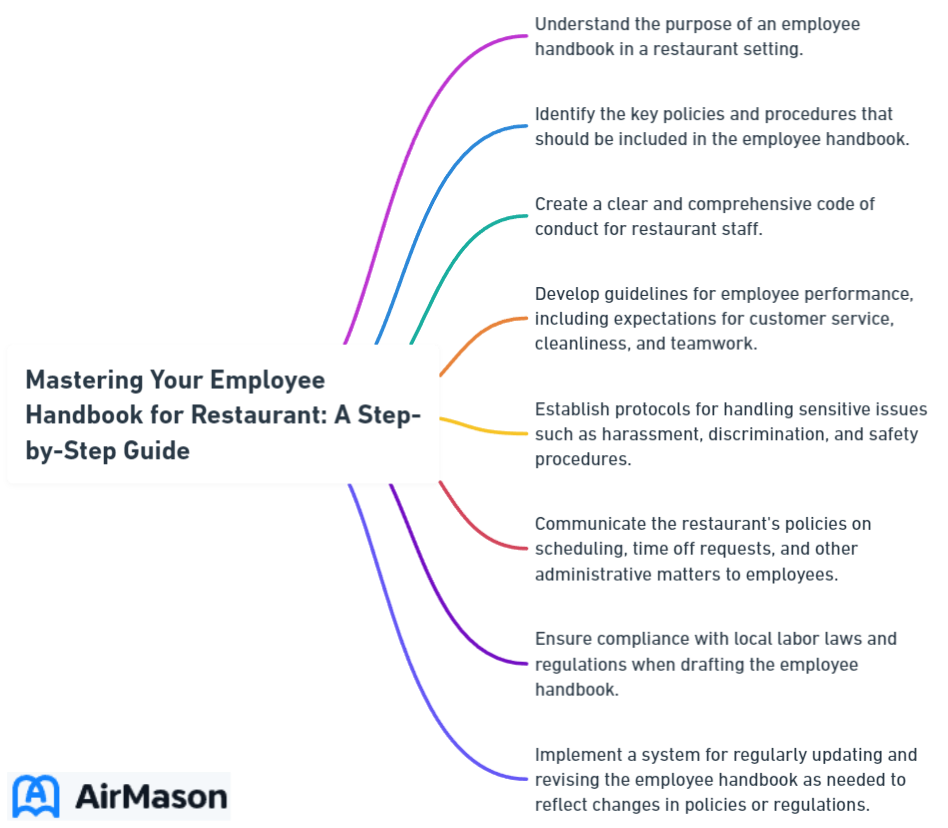
Why is an employee handbook for restaurant crucial for your restaurant’s success? It’s the blueprint that communicates your vision, sets employee expectations, and shapes your company culture. Dive into this article for structured, practical steps to build an employee handbook tailored to the bustling, unique environment of the restaurant industry.
Key Takeaways
- A restaurant employee handbook is a key ambassador of the restaurant’s brand, setting expectations and promoting a cohesive culture to decrease turnover.
- Defining your restaurant’s mission and core values is essential, as they guide employee behavior, business decisions, and help differentiate your restaurant in the market.
- The handbook should cover essential policies and procedures, including workplace behavior, scheduling, compensation, health and safety guidelines, harassment policies, and use of technology, to ensure a well-informed and compliant workforce.
Crafting Employee Handbook
Crafting an employee handbook is a crucial task for any organization aiming to establish clear guidelines and expectations for its employees. The process involves meticulous attention to detail to ensure that all policies, procedures, and expectations are accurately documented. It’s essential to tailor the handbook to the specific needs and culture of the company, considering factors such as industry standards, legal requirements, and company values. Moreover, regularly updating the handbook is necessary to reflect any changes in policies or regulations, ensuring that employees have access to the most current information. By investing time and effort into crafting a comprehensive employee handbook, organizations can promote transparency, consistency, and compliance within their workforce, ultimately contributing to a more productive and harmonious work environment.
Crafting the Perfect Restaurant Employee Handbook

Ever wondered why many restaurant owners emphasize the importance of a restaurant employee handbook? It’s because an engaging handbook is essentially an ambassador for your restaurant’s brand. It introduces new hires to your restaurant’s core values and policies, setting the tone for employee engagement and appropriate workplace behavior. Employee handbooks, especially those tailored for restaurants, serve as a powerful tool for employee relations and a reference point for your restaurant’s mission, employment policies, and staff training programs.
Setting the Tone
Much like seasoning a dish, setting the tone for your handbook enhances the flavor and leaves a lasting impression. Your handbook should mirror your restaurant’s brand and culture, promoting a positive work culture to reduce employee turnover.
An inviting introduction, a personal welcome letter from the restaurant owner, and a brief history of your restaurant can add that personal touch, making your employees feel part of your restaurant’s journey.

Customizing Content
Just as a one-size-fits-all approach doesn’t work in the restaurant industry, your employee handbook should also avoid it. It should be as unique as your restaurant, tailored to its size, location, and target market. The content should reflect your restaurant’s specific operational procedures and service styles, ensuring all team members are on the same page. Utilizing an employee handbook template can help you achieve this customization.
For instance, a fine dining restaurant might focus on table settings, while a pizza place might emphasize telephone etiquette.
Defining Your Restaurant’s Mission and Core Values

A restaurant without a mission is like a ship without a compass. Your mission statement provides direction and differentiates your establishment from competitors. It articulates why your restaurant exists, its goals, and its unique value proposition. Coupled with core values, which establish everyday standards and influence hiring decisions, it gives your employees a sense of purpose and aligns them with your restaurant’s overarching objectives.
The upcoming section will provide guidance on crafting a mission statement and core values that mirror your restaurant’s brand positioning, reflecting its unique voice and aesthetics.
Aligning with Company Goals
Far from just being words on paper, your mission statement and core values should influence every business decision you make. From hiring new staff to introducing a new menu item, the question should always be, ‘Does this serve our mission?’ This alignment not only solidifies your restaurant’s identity but also fosters a shared vision, inspiring your team to work towards common goals and promoting unity within your organization.
It ensures your decisions are not just profit-driven but ethically sound and socially responsible, promoting a positive workplace culture.
Communicating Expectations
The importance of clear and consistent communication of your mission and core values matches that of defining them. They should be woven into your policies and practices, hiring, and training programs. Reinforce them during staff meetings, training sessions, and performance reviews. Celebrate behaviors and outcomes that exemplify them.
This approach ensures your restaurant’s core values and mission are more than just a section in your handbook; they become a living, breathing part of your restaurant’s culture.
Outlining Roles and Responsibilities

Clarity is the key to accountability. A detailed organizational chart and thorough job descriptions for each position in your handbook can help establish this clarity. Not only do they aid your employees in understanding their roles and responsibilities, but they also provide a clear depiction of the restaurant’s staff structure.
This approach ensures that everyone knows who’s who in the zoo, fostering better team management and coordination.
Organizational Structure
Your organizational chart is a snapshot of your restaurant’s hierarchy. It might look like a family tree, but it does more than just show who’s who. It provides an overview of the different departments and their hierarchy within your restaurant.
Choosing the right type of organizational chart for your restaurant—be it hierarchical, functional, matrix, or circular—reflects its size, departments, hierarchy, and promotes a sense of unity and accessibility.
Job Descriptions
A job description can be likened to a recipe, delineating the ingredients (skills and qualifications) and steps (roles and responsibilities) necessary for creating a successful employee. It’s essential to create clear and comprehensive job descriptions for each role in your restaurant, tailored to your specific service style and concept.
From the executive chef to the dishwasher, each job description should highlight the importance of each role and set clear expectations for potential job candidates.
Establishing Workplace Policies and Procedures

Every successful restaurant operates on a set of well-defined policies and procedures. They serve as a roadmap for your employees, guiding them on what is expected of them and how to perform their duties effectively. Your restaurant employee handbook template needs to incorporate details about these policies and procedures, including elements like a code of conduct, scheduling policies, and emergency preparedness protocols.
This section ensures that your restaurant operates on an ‘at-will’ basis, adheres to local laws, and reflects your company culture.
Code of Conduct
Your restaurant’s code of conduct, or restaurant employee rules, should clearly articulate your expectations on:
- Dress code
- Smoking
- Substance use
- Cell phone usage
- Social media conduct
It’s more than just a list of do’s and don’ts. It’s a reflection of your restaurant’s values and standards.
A well-defined code of conduct not only ensures uniformity and professional behavior but also reinforces your commitment to creating a positive workplace culture.
Scheduling and Time Off
Scheduling is an art, and like every art form, it requires clear guidelines. Your handbook should outline comprehensive scheduling policies, including procedures for shift swaps, time-off requests, and holiday allowances. This approach ensures your employees know when they are expected to work, how to request time off, and what to do in case of conflicts, ensuring a smooth operation of your restaurant.
Compensation and Benefits Overview
Let’s face it, one of the key reasons people work is to earn a living. That’s why detailing employee compensation in your handbook is critical. But it’s not just about how much you pay your employees. It’s also about the benefits and perks you offer.
Attracting top talent and promoting staff retention, which ensures the long-term success of your restaurant, can be achieved with a well-defined pay structure and a comprehensive benefits package.
Pay Structure
Your pay structure is more than just numbers on a paycheck. It’s a reflection of your commitment to providing fair compensation to your employees. Your handbook should clearly outline wage rates, overtime policies, and payment methods, ensuring compliance with the Fair Labor Standards Act (FLSA). This approach ensures transparency, promotes trust, and fosters a sense of fairness among your employees.
Employee Benefits
Benefits are like the cherry on top of a sundae. They add extra sweetness to your employees’ compensation package. But it’s not just about offering standard benefits like health insurance and retirement plans. Unique benefits such as staff parties or outings and meal discounts cater to the hospitality industry’s culture, making your restaurant a great place to work at.
Offering competitive benefits not only makes your employees feel valued but also promotes staff retention.
Health and Safety Guidelines

A safe and healthy workplace is a productive workplace. Equipping your team with health and safety resources such as food safety and allergen awareness, along with emergency preparedness protocols, should be a crucial part of your employee handbook. This section ensures your employees are prepared for various health-related situations and unexpected accidents, fostering a safe and secure work environment.
Food Safety and Allergen Awareness
Food safety is non-negotiable in the restaurant industry. Your restaurant employees should be well-versed in food allergy prevention, cross-contamination avoidance, and emergency response procedures for food allergy incidents.
This section equips your employees with the knowledge and skills to provide safe meals to your guests, ensuring your restaurant’s reputation for food safety and customer satisfaction.
Emergency Preparedness
Emergencies can happen at any time. But being prepared can make all the difference. Your employee handbook should outline an emergency response plan, including specific procedures for natural disasters, power outages, and fire emergencies.
This approach ensures your staff are trained to handle crises effectively, safeguarding your restaurant and your employees.
Preventing Harassment and Discrimination
A workplace free from harassment and discrimination is not just a legal requirement under employment law; it’s a moral obligation. To ensure a safe and comfortable work environment, your employee handbook should include a comprehensive harassment and discrimination policy.
This section ensures your employees feel respected and valued, fostering a positive workplace culture.
Policy Development
Developing a comprehensive harassment and discrimination policy requires a collaborative approach, involving HR teams and professional advisors. Your handbook should clearly define harassment and discrimination, state a zero-tolerance policy, and provide a procedure for reporting complaints.
This approach ensures your policies are legally compliant, protecting your restaurant from potential legal issues.
Reporting and Resolution
Reporting and resolution are two key components of an effective harassment and discrimination policy. Your handbook should establish:
- A confidential and prompt investigation process for harassment complaints
- Clear consequences for harassment and discrimination
- Follow-up procedures to ensure resolution of complaints
This approach ensures your employees feel comfortable reporting incidents and confident that their complaints will be investigated thoroughly.
Technology and Tools Overview
In modern restaurants, technology, from POS systems and scheduling software to social media policies, plays a pivotal role. Accordingly, your employee handbook should encompass an overview of the technology utilized in your restaurant. This section ensures your employees are well-versed in using these tools, streamlining operations and enhancing customer service.
Training Resources
Training is the key to mastering new technology. Your handbook should offer training and resources for employees to learn how to use new tools like POS systems and scheduling software. This approach encourages staff buy-in, ensuring a smoother transition to new technology.
Troubleshooting Tips
Troubleshooting is an essential skill in the digital age. Your handbook should provide troubleshooting tips and resources for employees to handle common technology-related issues. This section ensures your employees feel confident handling minor hiccups, ensuring a seamless operation of your restaurant.
Summary
Creating a comprehensive restaurant employee handbook is no small feat. But as we’ve seen, the effort is truly worth it. From setting the tone and defining your mission and core values, to outlining roles and responsibilities, to establishing workplace policies and procedures, to detailing compensation and benefits, each section of your handbook plays a vital role in shaping your workplace culture, guiding employee behavior, and ensuring legal compliance. So, take the first step today in creating a handbook that truly reflects your restaurant’s brand, values, and vision.
Frequently Asked Questions
What an employee handbook should contain?
An employee handbook should contain a welcome letter, introduction to the company, EEOC statement, workplace policies and procedures, including hiring, attendance, payroll, breaks, paid time off, cybersecurity, privacy, and anti-discrimination. It should also include business policies, employee expectations, legal obligations, and employee rights.
How do you write a basic employee handbook?
When writing a basic employee handbook, make sure to include sections like Introduction & Welcome, Workplace Commitments, Company Policies and Procedures, and key policies like Attendance, Leave, Work Performance, and Discipline. It’s important to reflect the company’s values and gather feedback during the process.
What is legally required in an employee handbook?
Make sure your employee handbook includes important legal requirements like minimum wage and overtime regulations, anti-discrimination and harassment policies, family and medical leave policies, safety and health regulations, and more. Ensure your handbook covers all necessary policies to protect both your employees and your business.
What should be in a restaurant employee handbook?
Your restaurant employee handbook should include an introduction, disclaimer, confidentiality, company mission statement, code of conduct, procedures for emergencies, compensation and benefits overview, employment policies, and anti-harassment procedures to ensure a clear and positive work environment for your staff.
How can I communicate my restaurant’s mission and core values effectively?
You can effectively communicate your restaurant’s mission and core values by regularly incorporating them into staff meetings, training sessions, and performance reviews. It’s important to also integrate them into your policies and practices and acknowledge behaviors that exemplify them.
Important Disclaimer:
Please be aware that the content on this page has been generated by using artificial intelligence language models and may contain errors, inconsistencies, or outdated information. It is provided as-is without any warranties or guarantees of accuracy.
We strongly recommend using this content as a starting point for further research. We disclaim any liability for damages or losses resulting from the use or reliance on this content.